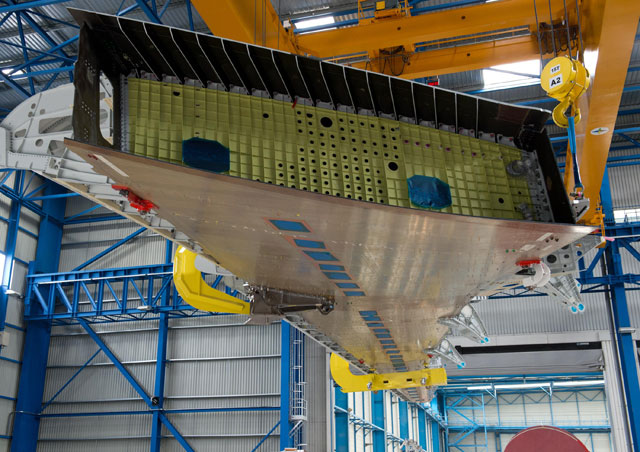When the Airbus A350 first took to the skies last week, much attention was focused on the Rolls-Royce Trent XWB powerplants that made the flight possible. But while the Trent XWB is the only engine available for the new big twin, R-R's arch rival GE is still on-wing.
Indeed, to an important extent, GE is the wing - the group's aviation division is a significant aerostructures supplier, and its UK facility at Hamble-le-Rice, Southampton, supplies Airbus with fixed trailing edge components for the A350.
That package - for 3,000 components, including structural composite panels and complex machined assemblies - is the largest production contract awarded to Hamble in its 75-year history, which began in 1936 when British Marine built the factory to make flying boats. The deal, under which GE is a risk-sharing partner, extends to all A350 variants, including the -800, -900 and -1000.
GE bought the Hamble facility in 2007 as part of a package of businesses it acquired from Smiths. But what was at that time a build-to-print supplier is being transformed into a full-function design and manufacturing partner, and a key element in GE's vision of its aerospace capability spanning propulsion, actuation and structures.
To that end, GE is building its capabilities base to be a broad-reaching participant in the next generation of civil aircraft.
At Paris, the company is presenting its Integrated Turboprop Propulsion Systems (ITPS) concept for future single-aisle airliners and regional aircraft, which brings together its capabilities in advanced wing and control surface design, with turboprop and propellers (GE Aviation owns the Dowty Propellers business).
Hamble is an important part of that process, as it relies heavily on the notion of integrating engine, wing structure and nacelle. According to Steve Walters, executive product leader for GE Aviation's aerostructures and nacelle activities, the objective is to position the group as a leading partner in the successor programmes to the Airbus A320 and Boeing 737 families, as well for regional airliners.
Between now and 2017, Walters envisions improving operational capability at plants such as Hamble, and establishing capacity in low-cost production environments such as China.
 |
|---|
Airbus |
Supplying wing components business for widebodies such as the A350 and new programmes will remain a focus, along with building global scale, until at least 2024. But during the 2018-2024 period much focus will be on the technologies needed to develop and integrate advanced wing architectures, while introducing products that GE believes will feature in an ITPS programme.
Hamble is due to see a $50 million composites facility investment dedicated to A350 and running in time to meet aircraft production ramp-up requirements. Work has already started, and the facility should be ready near the end of 2014.
This strategy exploits Hamble's position in the UK, where a significant chunk of the aerospace industry is dedicated to Airbus wings and wing components. Thus, the goal is to use wing components and design capability to move towards concepts for a high-performance integrated wing-nacelle-engine structure.
GE, says Walters, expects the industry to move towards propeller-driven regional aircraft.The ITPS concept should also inform any decision, ultimately, to move to open-rotor engines on larger aircraft. Ultra-high bypass ratio engines, which are being developed elsewhere in GE, are the other option for next-generation airliners, and Walters expects those to begin taking shape closer to 2030 than 2025.
But, he stresses, capability is a key decision factor; hence the importance of starting now to establish the design and manufacturing capability to make serious proposals for ITPS in the 2018-2024 period.
There are, he notes, three routes to performance improvement: aerodynamics; structural efficiency (reduced weight); and propulsion efficiency. ITPS is an attempt to tackle all three at once.
Source: Flight Daily News
















